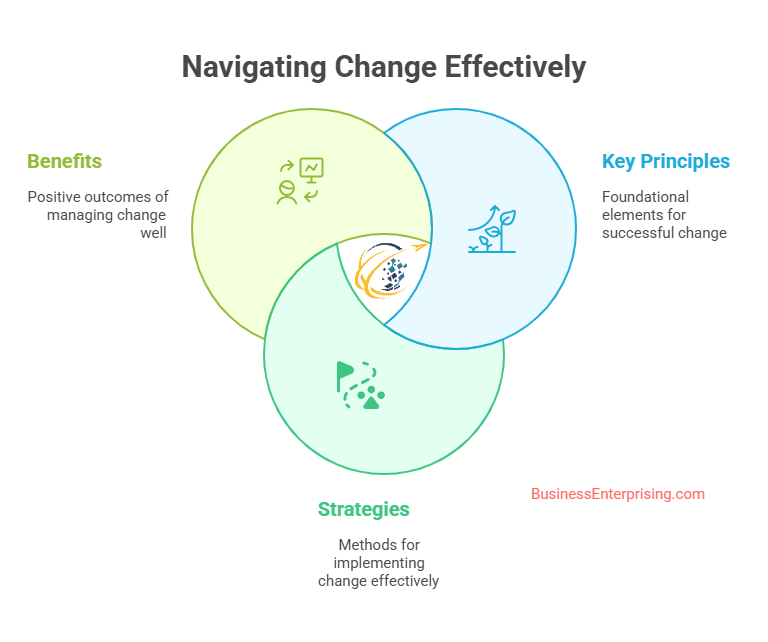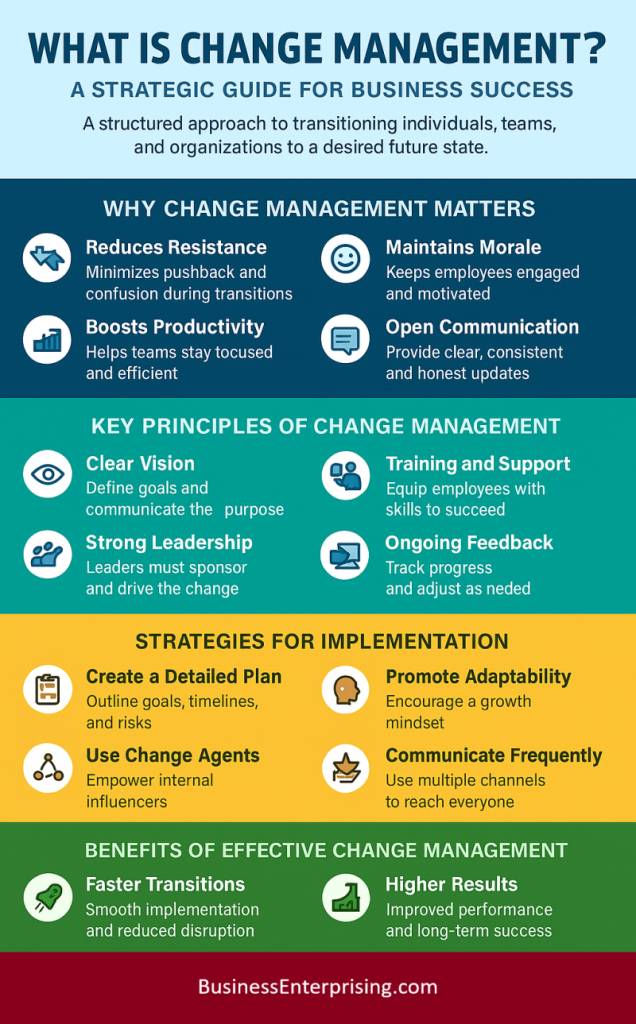
The Importance of Change Management
Firstly, it is essential to understand why change management is important. Organizations that handle change poorly often face resistance, decreased employee morale, as well as a drop in productivity. In contrast, effective change management can lead to smoother transitions, minimized disruptions, and enhanced performance. Moreover, with the rapid pace of change in today’s business environment, the ability to adapt quickly and efficiently has become a competitive advantage.
Change management also ensures that changes are implemented thoughtfully and systematically, thereby reducing risks and aligning the organization’s goals with its strategic vision. It involves planning, communication, training, and continuous monitoring to achieve successful outcomes. Consequently, mastering change management is not just beneficial but necessary for organizations aiming to thrive in a dynamic market.
Key Principles of Change Management
Effective change management is grounded in several key principles. These principles guide the process and help ensure that changes are sustainable and aligned with organizational goals. To understand what is change management, you need to start with its core principles. These are the building blocks that guide the entire process. Without a strong foundation, your efforts may fall short. Change affects people, so your approach must be thoughtful and consistent.
A clear vision helps everyone see the purpose behind the change. Therefore, always communicate goals and expected outcomes early. This sets expectations and creates alignment across teams. Additionally, leadership plays a major role in keeping efforts on track. Leaders must model the behaviors they want others to follow.
Strong sponsorship also builds trust. When leaders support change publicly, it signals that the change matters. However, communication needs to happen at every level. Consistent updates keep people informed and reduce confusion. Two-way feedback also helps you spot issues before they grow.
Engaging people throughout the process builds commitment. Therefore, include different teams in planning and execution. This creates buy-in and improves outcomes. Additionally, people adapt faster when they receive training and support. Give them the tools they need to succeed.
Finally, monitor results regularly and be open to adjustments. Conditions change, so your plan might need to shift. Feedback and flexibility help maintain momentum. Change is ongoing, not a single event. These principles make change feel less overwhelming and more manageable. If you’re wondering what is change management, it’s about getting people from point A to point B with purpose, direction, and support.
Clear Vision and Objectives
Firstly, having a clear vision and well-defined objectives is paramount. The desired outcome of the change must be articulated clearly, and the reasons behind the change must be communicated effectively. This clarity helps align the organization’s efforts and fosters a shared sense of purpose among employees.
Leadership and Sponsorship
Secondly, strong leadership and active sponsorship are critical. Leaders must champion the change, demonstrating commitment and providing the necessary support. This involves not only setting the direction but also inspiring and motivating employees to embrace the change. Effective sponsorship ensures that resources are allocated, and obstacles are addressed promptly.
Stakeholder Engagement
Engaging stakeholders throughout the process is another crucial principle. This involves identifying all affected parties and involving them in the planning and implementation stages. By addressing their concerns and incorporating their feedback, organizations can reduce resistance and increase buy-in.
Communication
Communication is the backbone of change management. Transparent, timely, and consistent communication helps manage expectations and keeps everyone informed. It is essential to convey the benefits of the change, the impact on individuals, and the steps involved. Effective communication also includes listening to employee concerns and providing regular updates on progress.
Training and Support
Providing adequate training and support is essential to equip employees with the skills and knowledge required to navigate the change. This may involve formal training programs, workshops, or on-the-job coaching. Additionally, offering ongoing support and resources helps employees adapt to new processes and systems.
Continuous Monitoring and Feedback
Finally, continuous monitoring and feedback ensure that the change is on track and any issues are addressed promptly. This involves setting measurable goals, tracking progress, and making necessary adjustments. Regular feedback loops help identify areas for improvement and reinforce positive behaviors.
Strategies for Successful Change Management
Implementing effective change management requires strategic planning and execution. Here are some key strategies to consider:
Develop a Comprehensive Change Management Plan
Firstly, developing a comprehensive change management plan is essential. This plan should outline the vision, objectives, timeline, and key milestones. It should also identify potential risks and mitigation strategies. A detailed plan provides a roadmap for the change process and helps ensure that all aspects are considered.
Foster a Culture of Adaptability
Building a culture of adaptability within the organization is crucial. This involves encouraging a growth mindset and fostering an environment where change is viewed as an opportunity rather than a threat. Leaders play a key role in modeling adaptable behaviors and reinforcing the value of continuous learning and improvement.
Utilize Change Agents
Change agents are individuals within the organization who support and advocate for the change. These individuals can be influential in driving adoption and addressing resistance. Identifying and empowering change agents helps create a network of support throughout the organization.
Communicate Early and Often
As previously mentioned, communication is critical. Organizations should communicate early and often, using multiple channels to reach all stakeholders. This also includes face-to-face meetings, emails, intranet updates, and social media. Providing opportunities for two-way communication helps ensure that employees feel heard and valued.
Provide Incentives and Recognition
Recognizing and rewarding positive behaviors can motivate employees to embrace the change. This may involve providing incentives for meeting change-related goals or recognizing individuals and teams who demonstrate adaptability and resilience. Positive reinforcement helps build momentum and reinforces the desired behaviors.
Address Resistance Proactively
Resistance is a natural response to change, but it can be managed proactively. By identifying potential sources of resistance early on, organizations can develop strategies to address concerns and mitigate risks. This may involve providing additional support, addressing misconceptions, or involving resistant individuals in the planning process.
Benefits of Effective Change Management
The benefits of effective change management are numerous. Firstly, it minimizes disruptions and ensures a smoother transition. Employees who are well-prepared and supported are more likely to adapt quickly and maintain productivity. Secondly, effective change management enhances employee morale and engagement. When employees feel involved and supported, they are more likely to embrace the change and contribute positively.
Moreover, successful change management drives organizational performance. By aligning changes with strategic objectives, organizations can achieve better outcomes and maintain a competitive edge. Additionally, it fosters a culture of continuous improvement and innovation, positioning the organization for long-term success.
Conclusion
So, what is change management? It’s a critical competency for organizations in today’s dynamic business environment. By understanding the key principles, employing strategic approaches, and fostering a culture of adaptability, companies can navigate change successfully. Effective change management not only minimizes disruptions but also enhances performance, engagement, and long-term sustainability. As change continues to accelerate, mastering change management will be essential for organizations aiming to thrive and succeed.


